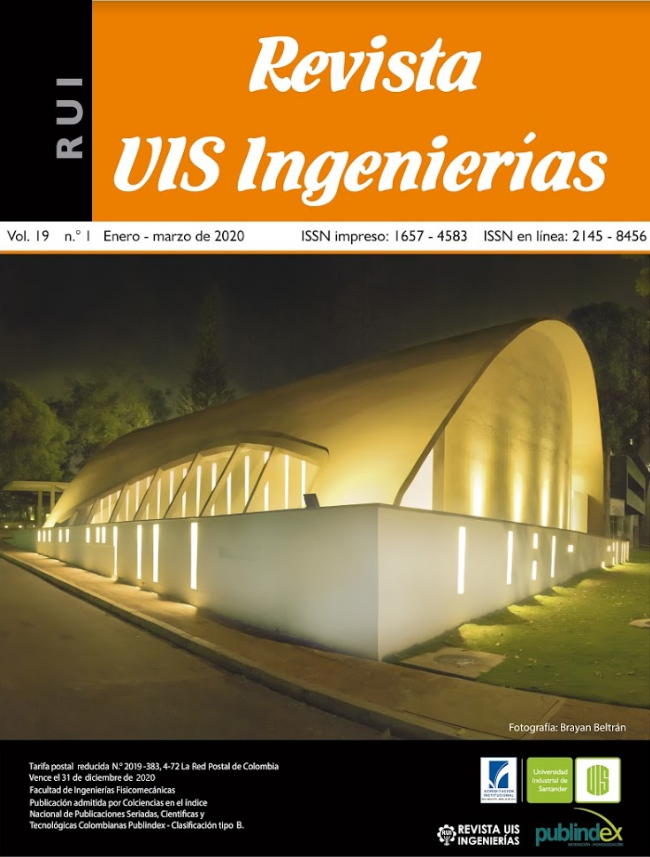Surface evaluation of carbon steel doped with nitrogen ions
Published 2020-01-04
Keywords
- ferrous alloys,
- superficial treatment,
- ion implantation,
- physicochemical characterization
How to Cite
Copyright (c) 2020 Revista UIS Ingenierías

This work is licensed under a Creative Commons Attribution-NoDerivatives 4.0 International License.
Abstract
This study proposes by means of analytical characterization techniques, a structural evaluation of the surface modification of a ferrous material by three-dimensional ion implantation plasma technology. Carbon steel substrates immerse in a gaseous atmosphere, were surface-implanted with nitrogen ions via high voltage pulse discharges activated at a low-pressure range (“high vacuum”). The effect of the surface treatment on the structure, composition, and morphology of the substrates was verified by microscopy and spectroscopy techniques. From the micrographs obtained by scanning electronic microscopy and the analysis elemental by energy dispersive spectroscopy the morphology and nitrogen concentration of the treated and non-treated samples were analyzed and compared. As for the elemental analysis by energy dispersive spectroscopy, nitrogen concentration in the implanted substrates were detected and determined at a relatively low amount. In regard to the x-ray diffraction results, a decrease in the intensity of the (110), (200) and (211) planes of the treated substrate compared with the reference substrate, was observed. The analysis of phases-formation on the surface material performed by Raman spectroscopy, identified mainly ferric oxy-hydroxides typical uniform corrosion products.
Downloads
References
[2] E. D. Niño, et al., “Aplicación de descargas simultáneas de alto voltaje y arco eléctrico para el tratamiento superficial avanzado de metales,” ITECKNE, vol. 9, no 1, pp. 14-20, 2012.
[3] E. Mccafferty, “Effect of ion implantation on the corrosión behavior of iron, stainless steels, and aluminum – A review”. Corrosion (NACE international), vol. 57, no 12, pp. 1011-1029, 2001.
[4] T. D. Radjabov, “Improvement of the corrosión properties of metals by ion implantation,” Rev. Vacuum, vol. 38, no 11, pp 979-985, 1988. doi: 10.1016/0042207X(88)90558-1.
[5] A. Pabón, “Estimación de la dosis y profundidad de iones implantados en la superficie de acero al Carbono,” degree final project, Universidad Industrial de Santander, 2014.
[6] L. Wegmann, The historical development of ion implantation. New York, US. Ziegler, J.F. 1984.
[7] A. Anders, “Metal plasm immersion ion implantation and deposition: a review,” Rev. Surface and Coatings technology, vol. 93, pp 158-167, 1997. doi: 10.1016/S0257-8972(97)00037-6
[8] H. J. Dulce, “Implantación iónica tridimensional mediante descargas de alto voltaje a bajas presiones del dispositivo JUPITER,” Ph.D. dissertation, Universidad Industrial de Santander, 2002.
[9] E. D. Niño et al. “Determinación de la velocidad de corrosión de aceros AISI SAE 1010, 1020, 1045 implantados con iones Ti,” Tumbaga, vol. 7, pp. 37-45, 2012.
[10] E. D. Niño, H.J. Dulce, V.D. Dougar, “Caracterización del Acero AISI 4140 implantado por iones Nitrógeno,” Rev. Colombiana de Física, vol. 42, no. 3, pp. 387-392, 2010.
[11] E.D. Niño, V.D. Dougar, “Comportamiento del acero SAE 4140 implantado con iones nitrógeno en ambientes hidrogenados,” Rev. Colombiana de Física, vol. 38, pp. 61-64, 2006.
[12] E. D. Niño, et al., “Behavior of AISI SAE 1020 steel implanted by Titanium and exposed to bacteria sulphate deoxidizer,” Journal of Physics: Conference Series, vol. 511, 012080, 2014.
[13] V. D. Dougar, J. Dulce, P. Tsygankov, “Implantación iónica tridimensional mediante descargas de alto voltaje a bajas presiones del dispositivo JUPITER,” Respuestas, vol. 8, pp. 19-30, 2002.
[14] F. Sanabria, “Desempeño en medio salino de un acero al carbono modificado superficialmente mediante implantación iónica tridimensional,” degree final project, Universidad Industrial de Santander, 2017.
[15] Standard practice for preparation of metallographic specimens, ASTM E3-95, 2001.
[16] Standard practice for preparing, cleaning, and evaluating corrosion test specimens, ASTM G1-03, 2011.
[17] H. Garnica, “Evaluación del desempeño de superficies en acero al Carbono implantadas con iones Titanio y Nitrógeno frente a bacterias sulfato reductoras,” degree final project, Universidad Industrial de Santander, 2016.
[18] V. I. Khvesyuk, P. Tsygankov, “The use of a hihgvoltaje discharge at low pressure for 3D ion implantation,” Surface and coatings, vol. 96, pp. 68-74, 1997.
[19] V. D. Dougar, J. Dulce, P. Tsygankov, “High voltaje pulse discharge for ion treatment of metals,” AIP, vol. 73, no. 2, pp. 828, 2002. doi: 10.1063/1.1429785
[20] D. Peña, et al., “Evaluación experimental de la resistencia a la corrosión de un acero AISI-SAE 4140 implantado con iones Nitrógeno,” Dyna, vol. 76, no. 159, pp. 43-52, 2009.
[21] X. Zhang, et al., “In situ Raman spectroscopy study of corrosion products on the surface of carbon steel in solution containing Cl- y SO4-2,” Engineering Failure Analysis, vol. 18, pp. 1981-1989, 2011. doi: 10.1016/j.engfailanal.2011.03.007
[22] M Reffass, et al., “Effects of NO2 ions on localised corrosion of steel in NaHCO3 + NaCl electrolytes,” Electrochimica Acta, vol. 53, pp. 7599-7606, 2007. doi: 10.1016/j.electacta.2006.12.040
[23] B.Y.R. Surnam, et al., “Investigating atmospheric corrosion behavior of carbon steel in coastal regions of Mauritius using Raman Spectroscopy,” Revista Materia, vol. 21, no. 1, pp. 157-168, 2016. doi: 10.1590/s1517707620160001.0014
[24] J. Alcantara, “An attempt to classify the morphologies presented by different rust phases formed during the exposure of carbon steel to marine atmospheres”, Materials Characterization, vol. 118, pp. 65-78, 2016. doi: 10.1016/j.matchar.2016.04.027
[25] D. De la Fuente, et al., “Characterization of rust surfaces formed on mild steel exposed tomarine atmospheres using XRD and SEM/Micro-Raman techniques,” Corrosion Science, vol. 110, pp 253-264, 2016. doi: 10.1016/j.corsci.2016.04.034
[26] A. Fraga, et al., “Soil Corrosion of the AISI1020 steel buried near electrical power transmission line towers,” Materials Research, vol. 17, no 6, pp 16371643, 2014. doi: 10.1590/1516-1439.305714.
[27] M. Criado, S. Martínez, J. M. Bastidas, “A Raman spectroscopy study of steel corrosion products in activated fly ash mortar containing chlorides,” Construction and Building Materials, vol. 96, pp 383390, 2015. doi: 10.1016/j.conbuildmat.2015.08.034
[28] J. Sei, D.C. Cook, “Townsend H.E. Characterization of iron oxide commonly formed as corrosion products on Steel,” Hyperfine Interactions, vol. 112, pp. 59-66, 1998. doi: 10.1023/A:1011076308501
[29] F. Sanabria, F. Viejo, E.D.V. Niño, “Performance in saline environment of a carbon steel surface modified by three dimensional ion implantation,” Journal of Physics: Conference Series, vol. 1403, pp 1-7, 2019.

